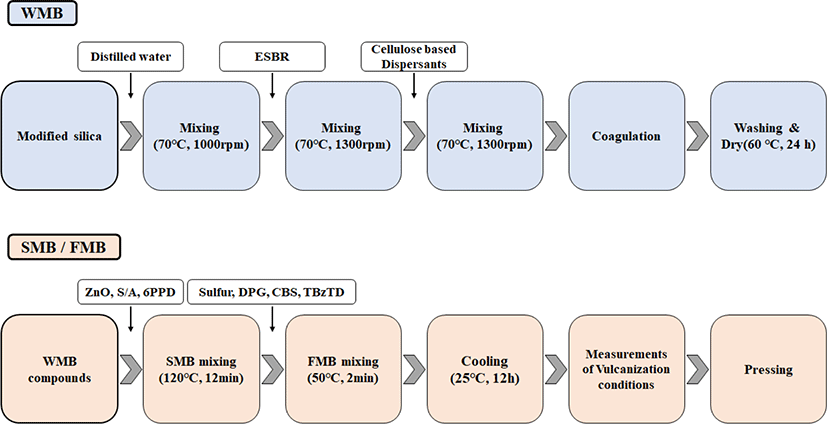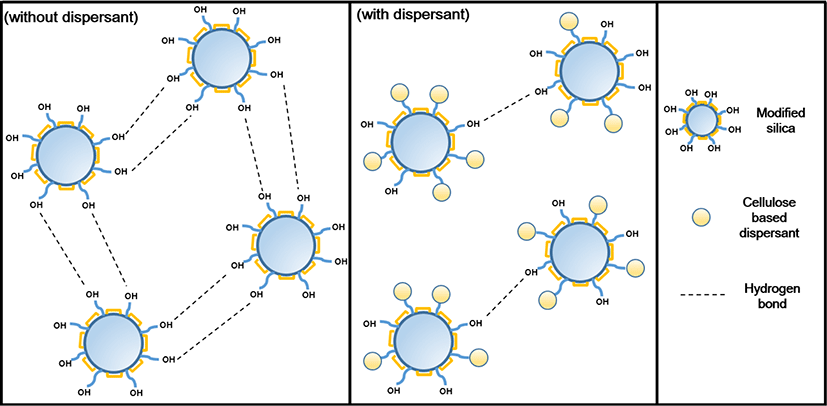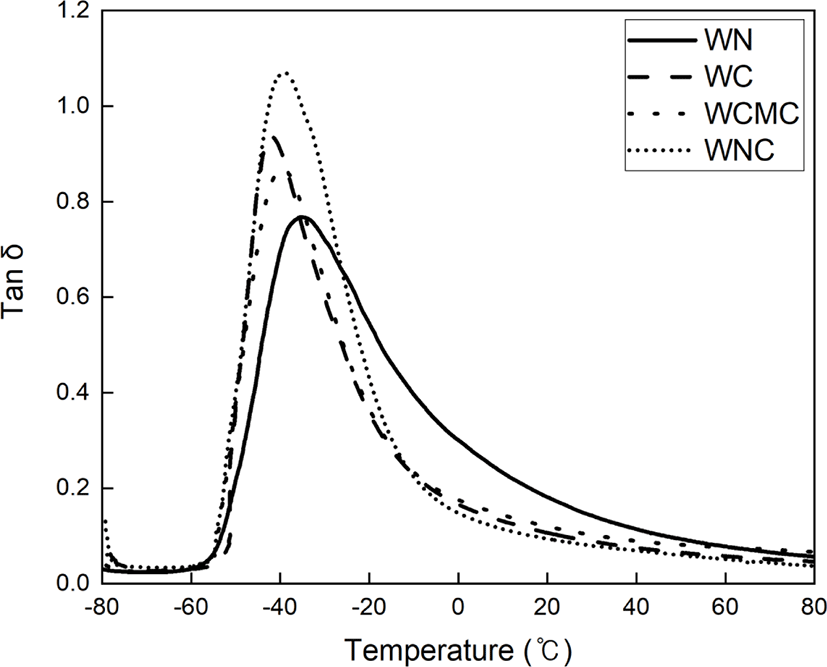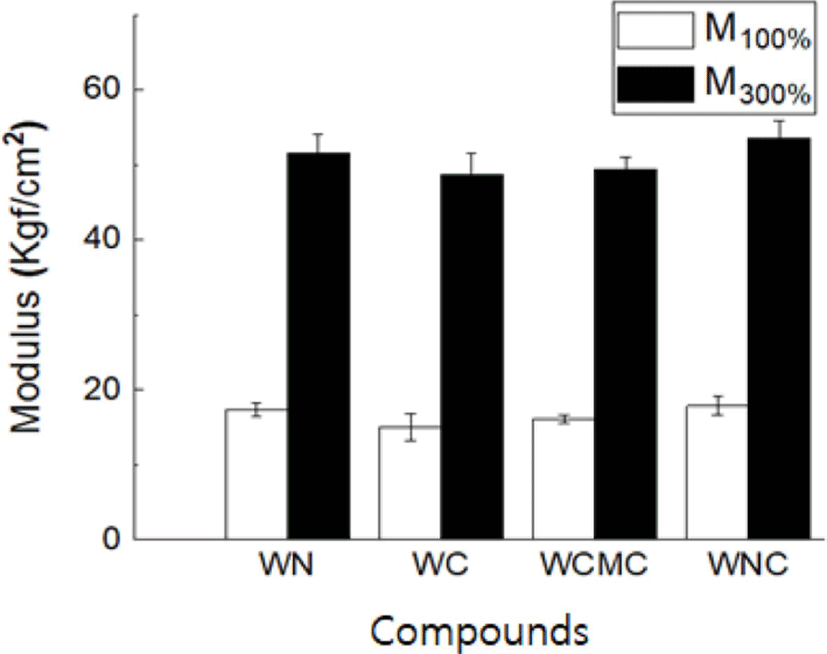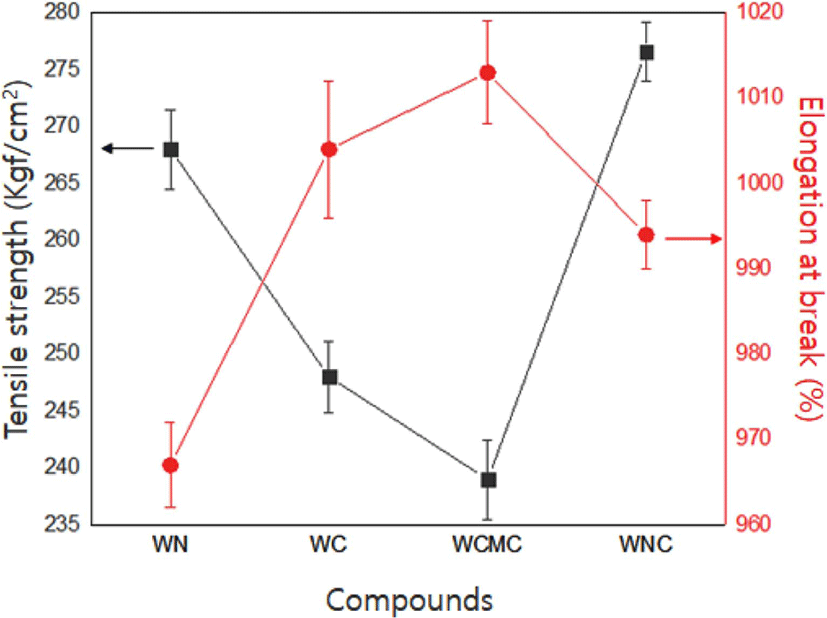Article
Influence of Nano-Cellulose Dispersant on the Vulcanization Characteristics, Viscoelastic Properties, and Mechanical Properties of Silica-SBR Compounds
Jung Soo Kim1, Dong Hyun Kim1,†
1Department of Human and Culture Convergence Group, Korea Institute of Industrial Technology (KITECH), Republic of Korea
© Copyright 2020 The Rubber Society of Korea. This is an Open-Access article distributed under the terms of the
Creative Commons Attribution Non-Commercial License (http://creativecommons.org/licenses/by-nc/4.0/) which permits
unrestricted non-commercial use, distribution, and reproduction in any
medium, provided the original work is properly cited.
Received: Jul 17, 2020; Revised: Aug 22, 2020; Accepted: Aug 26, 2020
Published Online: Sep 30, 2020
Abstract
Silica/SBR (styrene–butadiene rubber) compounds are the primary constituents of tire treads. Furthermore, the excellent dynamic viscoelastic properties of silica lead to good fuel efficiencies. However, the silanol group on the surface of silica does not mix well with non-polar rubber because of its polarity. This incompatibility causes aggregation due to the occurrence of hydrogen bonding between the hydroxyl groups, thereby reducing the dispersibility of silica. Recently, the wet master batch (WMB) process has been applied to overcome these disadvantages, and research on silica dispersants that can be used in the WMB process has been increasing. In this study, we prepared silica/SBR compounds by using three types of eco-friendly cellulose-based dispersants in the WMB process, namely: cellulose-, sodium carboxymethyl cellulose, and nanocellulose-based dispersants. Subsequently, we compared the vulcanization characteristics, viscoelastic properties, and mechanical properties of the compounds. The silica dispersibility in the rubber compounds was improved with the addition of the nano-cellulose dispersant, resulting in the enhancement of the workability, hardness, tensile strength, and wear resistance of the SBR compound.
Keywords: cellulose; silica; SBR; dispersant; tire tread
Introduction
자동차의 효용성이 증가함에 따라 타이어 시장이 확대되고 있다. 대표적인 합성고무인 스티렌-부타디엔 고무 (SBR)는 내마모성이 뛰어나고 수명이 길어 타이어의 가장 외부 층인 트레드에 많이 사용된다. 타이어 트레드는 자동차의 습윤 제동과 스노우 제동, 연비 등에 영향을 주는 가장 중요한 부분으로 최근까지 대표 소재인 SBR 기반의 복합체 제조 기술이 다양하게 연구되고 왔다. 특히 타이어 트레드의 비용절감 및 성능향상에 중요한 역할이 되는 보강 충전제 연구가 다수 보고되었으며,1,2 그 중 고무와 혼화성이 좋고 표면의 작용기로 인해 우수한 기계적 물성을 나타내는 카본블랙이 널리 사용되어 왔다.3 하지만 최근 타이어 마모 시 발생하는 카본블랙의 인체 유해성 문제가 대두됨에 따라 타이어산업에서는 실리카와 같은 친환경 소재로 대체하는 데에 주목하고 있다.4,5,6
실리카는 카본블랙과 비교하여 동적점탄특성 즉 회전저항이 낮고, 습윤제동, 스노우 제동이 개선되어 연비효율이 좋다. 최근 추가적인 성능개선을 위해 100phr 이상 고함량의 실리카 고무 배합물에 대한 연구가 진행 중이다.7-11 하지만 실리카는 표면의 실라놀기로 인해 높은 극성을 띠고 이로 인해 비극성인 고무와 잘 섞이지 않으며, 하이드록실기 간의 수소결합으로 응집현상이 발생하여 분산성이 떨어진다.12-15
최근 실리카 분산성 문제를 해결할 수 있는 wet master batch (WMB) 공정이 도입되고 있는데, WMB공정은 기존 모든 첨가물을 한 번에 고온에서 섞는 dry master batch (DMB) 공정과는 달리 수상에서 혼합이 이뤄지기 때문에 실리카 분산성이 우수하다. 또한, 표면이 개질된 실리카를 사용하기 때문에 공정에서의 에너지효율이 향상되고 알코올 등의 부산물 발생이 없으며, 수상 공정이기 때문에 실리카 분진이 줄어 작업환경이 개선되는 장점도 있다.16-19 하지만, 고함량 실리카를 적용할 경우, 실리카 분산성에 한계가 있기 때문에 이를 개선하기 위한 분산제 적용이 검토 되어야 한다. 일반적인 실리카 분산제는 아연, 칼륨과 같은 금속염 지방산 유도체인데, 분산제 내 금속이온이 실리카 표면의 하이드록실기와 반응을 통해 실리카끼리의 응집을 방해하여 실리카 분산성을 향상시킨다. 그 외에는 개질 점토, 카본 나노 튜브, 폴리피롤, 나노 카올린 등을 첨가하여 실리카 분산성문제를 해결한 연구가 보고된 바 있으나,20-22 DMB 공정에 한정되어 있고 WMB 공정에 적용 가능한 실리카 분산제는 아직 보고된 바가 없다.23,24 이에, 최근 WMB 공정에 적용 가능한 실리카 분산제의 필요성이 대두되고 있으며, 친환경 재료 기반의 분산제 연구에 대한 기대가 높아지고 있다.25,26 그 중에 천연고분자인 셀룰로오스는 재활용이 가능하며 기계적 물성이 우수하기 때문에 그린타이어의 재료로 검토되어 왔으며, DMB 공정에 적용되어 타이어의 가공성과 기계적 물성을 개선한 연구가 보고된 바 있다.27,28 본 연구에서는 WMB 공정을 이용한 SBR-실리카 배합물을 제조하기 위하여 셀룰로오스계 물질 3종을 분산제로 적용하고, 나노 셀롤로우스 분산제가 silica-SBR 배합물의 가황특성, 점탄성 특성 및 기계적 물성에 미치는 영향을 비교 분석하였다.
Experimental
1. Materials
실리카-SBR 배합물 제조를 위해 E-SBR 1723 (KUMHO PETROCHEMICAL, South Korea)를 사용하였으며 10 wt%의 bis [3-(triethoxysilyl) propyl] tetrasulfide (TESPT)로 개질된 표면개질 실리카 NK153 (MIRAESI, South Korea)가 사용되었고 응고제로는 2 wt% CaCl2가 사용되었다. 셀룰로오스계 분산제로는 cellulose (Sigma Aldrich, United States), sodium carboxymethyl cellulose (CMC, Sigma Aldrich, United States) 및 nano cellulose (NC, Borregaard, Norway)가 사용되었다. zinc oxide (ZnO)와 stearic acid (S/A)는 가교활성제로 사용되었으며, N-(1,3-dimethyl-butyl)-N'-phenyl-p-phenylenediamine (6PPD, Sigma Aldrich, United States)는 산화방지제로 사용되었다. Sulfur (SAMCHUN, South Korea)는 가교제로 사용되었으며 가황촉진제로 N-cyclohexyl-2-benzothiazole sulfonamide (CBS, Tokyo Chemical Industry, Japan), diphenyl guanidine (DPG, Sigma Aldrich, United States), TetraBenzyl Thiuram Disulfide (TBzTD, Sigma Aldrich, United States)를 사용하였다.
2. Preparation of the silica–SBR compounds
실리카-SBR 배합물은 WMB, SMB (silica master batch), 그리고 FMB (final master batch) 공정을 걸쳐 제조된다 (Figure 1). WMB 공정은 먼저 TESPT로 표면개질 된 실리카를 증류수에 첨가하여 5분 동안 1000 rpm 으로 교반 후 1300 rpm으로 5분동안 교반한다. 이후 E-SBR을 첨가하고 5분동안 교반을 진행한 후에 증류수에 녹인 셀룰로오스계 분산제를 첨가한다. 5분동안 교반을 진행한 후 E-SBR의 응집을 위해 CaCl2를 첨가하며, 응집된 실리카-SBR 배합물을 증류수로 세척한 후 60℃에서 24시간 동안 건조를 진행하여 공정을 완료한다. 건조된 실리카-SBR 배합물은 ZnO, S/A 및 6PPD를 니더기 (kneader)에 넣고 120℃에서 12분간 믹싱한 후, 투롤밀 (Two Roll Mill)을 이용하여 SMB 화합물을 제조한다. FMB 공정은 SMB 화합물과 sulfur, CBS, DPG, 그리고 TBzTD 니더기에 넣고 50℃에서 2분간 배합을 진행하며, 투롤밀을 이용하여 최종적으로 실리카-SBR 배합물을 제조한다. 실리카-SBR 배합물의 구성성분은 Table 1에 나타냈으며, phr은 E-SBR의 함량을 100phr로 잡았을 때의 각각의 함량을 나타낸다.
Table 1.
WMB, SMB, and FMB Compositions of Silica–SBR Compounds with Cellulose-Based Dispersants
|
Compounds |
WMB |
SMB |
FMB |
|
E-SBR/Silica (phr) |
1TESPT (phr) |
Dispersants (phr) |
2ZnO/3(S/A)/46PPD (phr) |
Sulfur/5CBS/6DPG/7TBzTD (phr) |
|
WN |
100/100 |
10 |
0 |
3/(2)/1 |
1.5/1.5/0.1/0.2 |
|
WC |
2 |
|
WCMC |
2 |
|
WNC |
2 |
Download Excel Table
3. Measurement
3.1. Cure characteristics
제조가 완료된 실리카-SBR 배합물의 가황특성은 진동 각 ±1°, 온도 160℃ 조건으로 moving die rheometer (MDR, MDR2020, MYUNGJI TECH)로 30분간 측정되었으며 최소 토크 값 (Tmin), 최대 토크 값 (Tmax), 스코치 시간 (t10) 및 최적 가황 시간 (t90)을 측정했다.
3.2. Viscoelastic properties
실리카-SBR 배합물의 유리전이온도와 점탄성 특성은 dynamic mechanical analysis (DMA, DMA Q800, TA)를 이용하여 ASTM D 4065 에 따라 측정하였다. 측정된 Tan δ은 60°C에서 연비 특성, 0°C, −30°C에서 제동 특성 등을 비교하였다.
3.3. Mechanical properties
실리카-SBR 배합물의 기계적 특성은 ASTM D412에 따라 측정되었다. 100 mm (길이) × 25 mm (너비) × 2 mm (두께)의 Dog bone 시편을 제작한 후 universal testing machine (H5KT-0635, Tinius Olsen)을 이용하여 연신율, 인장강도 및 모듈러스 값을 측정하였다. 실리카-SBR 배합물의 내마모성은 ASTM D 5963에 따라 DIN 마모 시험기(AT-2020-D, MYUNGJI TECH)를 사용하여 측정하였고, 경도는 Durometer Hardness (Shore type) 를 이용하여 ASTM D2240 규정에 따라 평가하였다. 모든 시험은 3회씩 측정하여 평균값을 나타내었다.
Results and Discussion
1. Expected mechanism between silica and cellulose-based dispersants
Figure 2는 WMB 공정에서의 실리카와 셀룰로오스계 분산제의 결합 메커니즘을 보여준다. 실리카의 경우 표면에 하이드록실기끼리의 수소결합으로 인해 응집이 일어나기 때문에 실리카 분산성이 떨어진다. 셀룰로오스계 분산제 또한 표면에 하이드록실기를 보유하고 있기 때문에 실리카 표면의 하이드록실기와 수소결합을 하게 된다. 셀룰로오계 분산제는 실리카간의 수소결합을 일부 대체하여 실리카의 응집을 방지하고 분산성을 향상시킬 수 있다.
Figure 2.
Illustration of expected mechanism between silica and cellulose-based dispersants in the WMB process.
Download Original Figure
2. Cure characteristics
셀룰로오스계 분산제를 적용한 실리카-SBR 배합물의 cure characteristic을 MDR 측정결과로 표시하였다. t10은 일명 스코치 타임으로 실리카-SBR 배합물의 전체 가황단계의 10%까지 도달한 시점까지의 반응시간을 의미한다. t10의 시간이 길수록 가황이 이루어지기 전 고무의 물성을 가공할 수 있는 시간이 길어졌다. t90은 실리카-SBR 배합물의 전체 가황단계의 90%까지 도달한 시점까지의 반응시간을 의미하며 실질적인 최적가황시간으로 표현한다. t90의 시간이 짧을수록 최적가황 시간이 짧아져 고무의 제조공정 시간이 짧아지므로 가공성이 좋다. Tmin 값은 실리카-SBR 배합물의 최소 토크 값을 의미한다. Tmin 값이 낮을수록 실리카-SBR 배합물의 유동성이 좋아서 점도가 낮음을 의미하고 이는 실리카의 분산성이 향상된 것을 의미한다. Tmax 값은 실리카-SBR 배합물의 최대 토크 값을 의미하는데, Tmax 값이 높을수록 실리카-SBR 배합물의 점도가 높아 최대 토크 값이 높아지고 기계적 물성에 밀접하게 영향을 미친다. Tmax-Tmin 값은 실리카-SBR 배합물의 최대 토크 값에서 최소 토크 값을 뺀 값으로, Tmax-Tmin 값이 클수록 가황이 잘 이루어졌음을 의미하고 이는 가교밀도와 관련이 있다.
Figure 3과 Table 2에 나타난 바와 같이, WC의 경우 WN에 비해 t10이 약 50초 정도 증가하여 가공할 수 있는 시간이 길어졌다. t90의 경우 약 1분 가량 감소하여 최적가황시간이 짧아져 가공성이 향상되었고, Tmin 값의 경우 약 31% 정도 감소하여 유동성이 증가하였다. Tmax 값의 경우 약 27% 정도 감소하였고, Tmax-Tmin 값은 약 25% 정도 감소하여 가교밀도는 저하되었음을 알 수 있다. WCMC는 WN에 비해 t10이 약 20초 정도 증가하여 가공할 수 있는 시간이 증가하였다. t90의 경우 약 3분 가량 증가하여 최적가황시간이 증가하여 가공성이 감소하였고, Tmin 값의 경우 약 23% 정도 감소하여 유동성이 증가하였다. Tmax 값은 약 17% 정도 감소하였으며, Tmax-Tmin 값은 약 14% 정도 감소하였다. WNC의 경우는 WN에 비해 t10이 약 1분 정도 증가하여 가공할 수 있는 시간이 가장 높게 증가하였다. t90의 경우 약 3분 가량 증가하여 최적가황시간이 증가하여 가공성이 감소하고, Tmin 값은 약 26% 정도 감소하여 유동성이 증가하였다. 유동성의 증가는 실리카의 분산성 향상이 영향을 미쳤을 것으로 추측된다. Tmax 값의 경우 약 24% 정도 감소하고, Tmax-Tmin 값 또한 약 23% 정도 감소하여 가교밀도는 감소되었음을 확인하였다.
Table 2.
Cure Characteristics Data of Silica–SBR Compounds with Various Dispersants
|
Compounds |
WN |
WC |
WCMC |
WNC |
|
t10 (min) |
02:35 |
03:26 |
02:59 |
03:35 |
|
t90 (min) |
15:04 |
16:03 |
18:24 |
18:27 |
|
Cure rate (N∙m/min) |
0.308 |
0.201 |
0.178 |
0.163 |
|
Tmin (N∙m) |
0.768 |
0.609 |
0.595 |
0.569 |
|
Tmax (N∙m) |
2.768 |
2.283 |
2.320 |
2.114 |
|
Tmax-τmin (N∙m) |
2.000 |
1.674 |
1.725 |
1.545 |
Download Excel Table
3. Viscoelastic properties
Tan δ 값은 손실 탄성 모듈러스 값을 저장 탄성 모듈러스 값으로 나누어 나타내는 값으로, 값이 높을수록 점성 특성에 가깝고 낮을수록 탄성 특성에 가깝다고 할 수 있다. Figure 4은 온도에 따른 Tan δ 값의 변화를 통하여 동적 점탄성 특성을 비교하였고, 주요 지표에 해당하는 값은 Table 3에 나타내었다. Tg (°C) 값은 Tan δ 값이 가장 높게 나타날 때의 온도로 WN이 가장 높은 값을 나타내고, WC가 가장 낮은 값을 나타내었다. Tg 값이 높을수록 실리카-SBR 배합물의 유연성이 떨어지는 경향이 있다. Tg에서의 Tan δ값은 일반적으로 실리카 분산도가 증가함에 따라 높게 나타날 수 있는데, WNC가 분산제를 적용하지 않은 WN 대비 약 40% 가량 높은 값을 나타내었으며, 스노우 제동 특성을 나타내는 −30°C에서의 저장 탄성율도 가장 낮은 값으로 우수하게 나타났다. 60°C 에서의 Tan δ 값은 낮을수록 연비특성이 우수하다고 볼 수 있는데, 이 또한 WNC 가 가장 우수한 값을 나타내었다. 다만, 0°C에서의 손실 탄성율 값은 높을수록 습윤제동 성능이 좋다고 볼 수 있는데, 분산제를 적용한 모든 샘플이 WN보다 낮게 나타나는 결과를 확인하였다.
Figure 4.
Tan δ changes of the silica-SBR compounds according to types of cellulose based dispersants.
Download Original Figure
Table 3.
Dynamic Viscoelastic Properties of the Silica-SBR Compounds According to Types of Cellulose Based Dispersants
|
Compounds |
WN |
WC |
WCMC |
WNC |
|
Tg (°C) |
−35.38 |
−41.85 |
−39.37 |
−39.10 |
|
Tanδ at Tg
|
0.768 |
0.935 |
0.867 |
1.070 |
|
E’ at –30°C (MPa) |
116.4 |
54.85 |
91.04 |
40.89 |
|
E’’ at 0°C (MPa) |
6.739 |
3.156 |
5.400 |
1.462 |
|
Tanδ at 60°C |
0.078 |
0.058 |
0.076 |
0.051 |
Download Excel Table
4. Mechanical properties
셀룰로오스계 분산제를 적용한 실리카-SBR 배합물의 기계적 물성을 측정하였다. M100%, M300% 는 각각 100%, 300% 신장에서의 모듈러스를 나타낸다(Figure 5).
Figure 5.
Tensile modulus of silica–SBR compounds according to types of cellulose based dispersants.
Download Original Figure
분산제 적용이 안된 WN과 비교하여 WC와 WCMC는 신장율 100%, 300% 일때 모두 모듈러스가 감소하는 경향이 나타났으며, WNC의 경우 신장율 100% 일 때의 모듈러스는 유사한 수준을 유지하고, 300% 일 때는 소폭 상승하는 경향을 확인하였다. 모듈러스는 타이어 트레드 성능의 직접적인 영향을 미치는 물성으로 분산제의 적용을 통한 실리카 분산 및 유동성 증가로 모듈러스의 감소를 예상했으나, 유사 수준 또는 그 이상의 수치를 나타내는 것으로 보아 적정 수준의 실리카 분산이 모듈러스 물성에 영향을 미친 것으로 판단된다.
Elongation at break은 실리카-SBR 배합물이 파열될 때까지의 신장율을 %로 나타낸 수치로, 가교밀도와 반비례하는 경향이 있고 인장강도는 가교밀도에 비례하는 경향이 있다 (Figure 6). 이에 따라, Cellulose 분산제와 CMC 분산제를 적용한 실리카-SBR 배합물은 가황특성에 나타난 가교 정도에 따라 인장강도는 감소하고 신장율은 증가하는 경향이 나타났으나, Nano cellulose를 적용한 WNC의 경우에는 신장율은 WN과 유사한 수준이지만 인장강도는 증가하는 경향이 있었다. 모듈러스와 마찬가지로 나노 크기의 셀룰로오스는 실리카-SBR 배합물 내에서 실리카 분산을 극대화하여, 유동성 증가 및 기계적 물성 향상에 기여하는 것으로 예상한다. 이에 따라 Figure 7에 나타낸 Hardness와 Wear resistance 성능에도 마찬가지로 분산제 투입 샘플 중에는 가장 높은 값의 Hardness를 나타내었고, Wear resistance 은 WN과 비교하여 약 10% 정도 감소하는 결과를 확인하였다.
Figure 6.
Tensile properties of silica–SBR compounds according to types of cellulose based dispersants.
Download Original Figure
Figure 7.
Hardness and wear resistance of silica–SBR compounds according to types of cellulose based dispersants.
Download Original Figure
Conclusions
본 연구에서는 WMB 공정을 이용하여 다양한 종류의 셀룰로오스 물질을 분산제로 적용한 실리카-SBR 배합물을 제조하였다. Cellulose, sodium carboxymethyl cellulose, nano cellulose 총 3종류의 셀룰로오스계 분산제가 사용하였으며, 분산제를 적용하지 않은 실리카-SBR 배합물과 비교하여 그 결과를 분석하였다. 이를 통해 각 실리카-SBR 배합물의 가황특성, 가공성, 그리고 기계적 물성을 확인하였는데, 3종류의 셀룰로오스계 분산제를 적용한 실리카-SBR 배합물은 분산제를 적용하지 않은 실리카-SBR 배합물에 비해 유동성이 좋아지고 가공성이 향상되었다. 특히, 나노셀룰로오스를 적용한 WNC는 점탄성 분석 결과를 통해 실리카의 분산성이 가장 우수한 것으로 나타났으며, 이로 인하여 스노우 제동 특성 및 연비 특성이 우수하게 나타남을 확인하였다. 향상된 실리카 분산성이 유동성에는 긍정적인 영향을 미쳤지만, cellulose와 sodium carboxymethyl cellulose는 일부 가황을 방해하여 가교밀도 저하 및 기계적 물성 저하를 나타내었다. 반면에 nano cellulose는 나노 입자의 분산제가 유동성 증가뿐만 아니라 실리카 분산에도 효과적으로 작용하여 경도 및 인장, 내마모성 등의 기계적 물성에서도 양호한 결과를 나타내었다. 이로써 나노셀룰로오스는 WMB 공정을 통하여 제조되는 실리카-SBR 배합물 내의 실리카 분산성을 향상시키는 분산제로써 효과적인 것으로 판단되었다.
Acknowledgments
본 연구는 산업통상자원부 산하 한국산업기술평가원이 연구 지원한 산업소재핵심기술개발사업(Grant No; 10067128) 의 일환으로 수행되었기에 감사드립니다.
References
Me-Chun Li, Xin Ge, and Ur Ryong Cho, “Emulsion Grafting Vinyl Monomers onto Starch for Reinforcement of Sty-rene-Butadiene Rubber”,
Macromol. Res.,
21, 519 (2013).


J. L. Valentín, P. Posadas, A. Marcos-Fernández, L. Ibarra, and A. Rodríguez, “Effect of a Fatty Amine on Processing and Physical Properties of SBR Compounds Filled With Silane–Silica Particles”,
J. Appl.,
99, 3222 (2006).


Z. Rigbi, “Reinforcement of rubber by carbon black”,
Properties of Polymers, 21 (2005).


G. Santos, “Road Transport and CO
2 Emissions: What are the Challenges?”,
Transp Policy,
59, 71 (2017).


N. Rivers and R. Wigle, “An Evaluation of Policy Options for Reducing Greenhouse Gas Emissions in the Transport Sector: The Cost-Effectiveness of Regulations Versus Emissions Pricing”,
Laurier Centre for Economic Research and Policy Analysis Working Papers, 107 (2018).

S. Wolff, “Chemical Aspects of Rubber Reinforcement by Fillers”,
Rubber Chem. Technol.,
69, 3 (1996).


C. M. Flanigan, L. Beyer, D. Klekamp, D. Rohweder, B. Stuck, and E. R. Terrill, “Comparative Study of Silica, Carbon Black and Novel Fillers in Tread Compounds”,
Rubber World,
245, 5 (2012).

J. W. Ten Brinke, S. C. Debnath, L. A. Reuvekamp, and J. W. Noordermeer, “Mechanistic Aspects of The Role of Coupling Agents in Silica–Rubber Composites”,
Compos. Sci. Technol.,
63, 8 (2003).


T. Xu, Z. Jia, S. Wang, Y. Chen, Y. Luo, D. Jia, and Z. Peng, “Self-Crosslinkable Epoxidized Natural Rubber-Silica Hybrids”,
J. Appl.,
134, 14 (2017).


H. D. Luginsland, J. Frohlich, and A. Wehmeier, “Influence of Different Silanes on the Reinforcement of Silica-Filled Rubber Compounds”,
Rubber Chem. Technol.,
75, 4 (2002).


S. S. Choi, “Influence of the Silica Content on Rheological Behaviour and Cure Characteristics of Silica-Filled Styrene- Butadiene Rubber Compounds”,
Polym. Int.,
50, 5 (2001).


Y. Gui, J. Zheng, X. Ye, D. Han, M. Xi, and L. Zhang, “Preparation and Performance of Silica/SBR Masterbatches with High Silica Loading by Latex Compounding Method”,
Compos. Part B-Eng.,
85, 130 (2016).


T. Jesionowski, J. Zurawska, A. Krysztafkiewicz, M. Pokora, D. Waszak, and W. Tylus, “Physicochemical and morphological properties of hydrated silicas precipitated following alkoxysilane surface modification”,
Appl. Surf. Sci.,
205, 212 (2003).


T. Jesionowski, F. Ciesielczyk, and A. Krysztafkiewicz, “Influence of selected alkoxysilanes on dispersive properties and surface chemistry of spherical silica precipitated in emulsion media”,
Mater. Chem. Phys.,
119, 65 (2010).


Y. J. Xie, Callum A. S. Hill, Z. F. Xiao, H. Militz, and C. Mai, “Silane coupling agents used for natural fiber/polymer compound: A review”,
Compos. Part A-Appl. S,
41, 806 (2010).


W. Kim, B. Ahn, H. Mun, E. Yu, K. Hwang, D. Kim, G. Ryu, and W. Kim, “Effect of Calcium Chloride as a Coagulant on the Properties of ESBR/Silica Wet Masterbatch Compound”,
Polymers,
10, 1116 (2018).




S. Prasertsri and N. Rattanasom, “Fumed and precipitated silica reinforced natural rubber compound prepared from latex system: Mechanical and dynamic properties”,
Polym. Test.,
31, 593 (2012).


Z. R. Chen, S. Araki, W. M. Cole, W. Hergenrother, and S. Warren. “Solution Masterbatch Process Using Fine Particle Silica for Low Hysteresis Rubber”, U.S. Patent, 7,312,271 (2007).

P. J. Wallen, G. C. Bowman, H. A. Colvin, C. J. Hardiman, and J. E. R. Reyna, “Processes for Making Silane, Hydrophobated Silica,Silica Masterbatch and Rubber Products”, U.S. Patent, 8,357,733 (2013).

K. W. Stöckelhuber, A. Das, R. Jurk, and G. Heinrich, “Contribution of physico-chemical properties of interfaces on dispersibility, adhesion and flocculation of filler particles in rubber”,
Polymers,
51, 1954 (2010).


Q. Liu, Y. Zhang, and H. Xu, “Properties of vulcanized rubber nanocomposites filled with nanokaolin and precipitated silica”
Appl Clay Sci,
42, 232 (2008).


C. Zhang, Z. Tang, B. Guo, and L. Zhang, “Concurrently improved dispersion and interfacial interaction in rubber/nanosilica composites via efficient hydrosilane functionalization”,
Compos. Sci. Technol.,
169, 217 (2019).


J. Y. Lee, T. Lee, K. Kim, B. Kim, G. Kwag, J. Y. Kim, and H. J. Paik, “Poly (styrene-r-butadiene)-b-poly (poly (ethylene glycol) methyl ether methacrylate) as a silica dispersant in rubber compounds”,
Polym. Int.,
63, 908 (2014).


Surya, I., Ismail, H., and Azura, A. R., “Alkanolamide as an accelerator, filler-dispersant and a plasticizer in silica-filled natural rubber compounds”,
Polym. Test,
32, 1313 (2013).


Siddharth Butani and Sachin Mane, “Coagulation/Flocculation Process for Cationic and Anionic Dye Removal using Water Treatment Residuals”,
IJESC,
7, 13476 (2017).

D. Dondi, A. Buttafava, C. Palamini, F. Pepori, A. Lostritto, L.Giannini, M. Nahmias, L. Conzatti, and A. Faucitano, “γ-RadiationInduced Functional Modification of Silica and Radiation Vulcanization of SBR-Silica compound”,
Macromol. Symp.,
301, 90 (2011).


K. Gopalan Nair and A. Dufresne, “Crab shell chitin whisker reinforced natural rubber nanocomposites. 1. Processing and swelling behavior”,
Biomacromolecules,
4, 657 (2003).



W. Helbert, J. Y. Cavaillé, and A. Dufresne, “Thermoplastic nanocomposites filled with wheat straw cellulose whiskers. Part I: Processing and mechanical behavior”,
Polym. Compos.,
17, 604 (1996).


